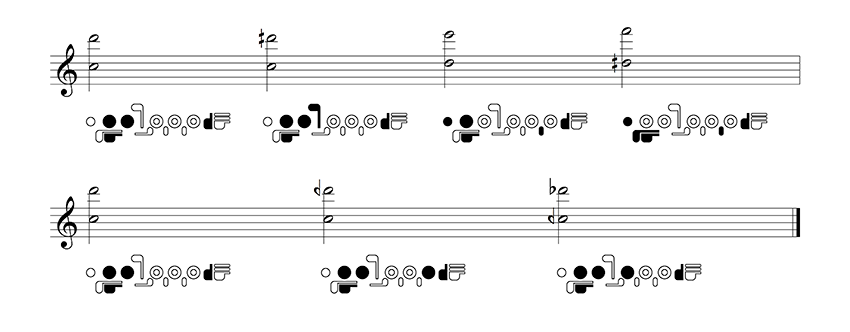If you go to any university or conservatory practice rooms early in the morning, you’ll hear the sounds of flocks of flutists practicing the “Moyse Exercise” (i.e. exercise 1 from On Sonority, Art & Technique by Marcel Moyse). We all have been told by our teachers that it’s one of the best and most fundamental tone exercises, but what can we do when we want to improve a specific aspect of our tone?
When we have a clear idea of what we want to achieve, it’s easier to reach those goals. Long term goals are important, but it is useful to have specific short term goals for each exercise, particularly for tone development.
To achieve a more focused tone:
- ppp long tones
- Harmonics
- Harmonic/regular notes
1. The goal of this exercise is to play as softly, and long as possible with as little air as possible. There should be no air noise when playing. All our attention should be focused on the tone, as if it were a meditation exercise.
Once you feel comfortable playing this exercise on Low B (or Low C, if you have a C-foot), you can go up the scale chromatically to the next note (C#, D, etc). Eventually, your goal is to be able to play very softly, with a pure tone in the high register, as well as in the low.

2. Play the harmonic series starting on Low C (or Low B), without increasing the volume of the sound. Start at a relatively comfortable dynamic (mf) and eventually try to play the same series in a softer dynamic (p).
Continue going up the scale chromatically with the harmonic series (C#, D, etc).

Variation: alternate between two harmonic overtones.
3. Play the following exercise, trying to match the harmonic fingering's resonance and tone quality to that of the regular fingering.
Continue playing this exercise until you reach B3, C4, C#4, or D, but be aware that some of the harmonics for those high notes are almost impossible to get without changing slightly the root fingerings.

To achieve a more resonant tone:
- Play - sing - play
- Multiphonics
- Whistle Tones
1. Play the following exercise matching the pitch of your singing voice to the note's pitch. Keep you mouth in the position of the vowel that you sang. Try different vowels (A, E, I, O, U, Ü) and listen to how the tone color changes (the changes are much more evident in the low register than in the middle and high registers).
Play this exercise on different notes and in different registers.

2. Play the following multiphonics. To be able to play both pitches in this multiphonic series your lips should be open enough in the center to allow for both pitches to be heard equally.

3. Play the following notes as whistle tones. Keep in mind that to obtain a pure tone you'll need to keep a relaxed embouchure, and aim at the correct point on the lip plate.
Play chromatically down and up the scale. Third octave notes are the easiest to start with.

You can also play this exercise by starting on the regular note, then playing the Whistle Tone, and finishing with the regular note again.
